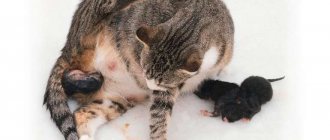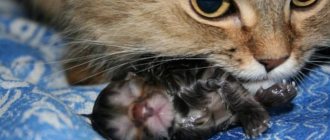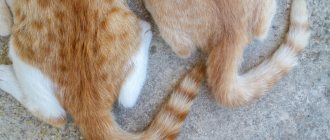- What can an owner do to help a cat during childbirth?
- What to do after giving birth to a cat?
Childbirth in a cat is a natural process that ends pregnancy and involves the fetus leaving the uterus through the cervix and vagina (birth canal).
First birth of a cat
As a rule, experienced cats themselves know what to do. But if a cat gives birth for the first time, problems may arise, since the cat does not have a good idea of what is happening to it. And in order to know how to help a cat give birth for the first time, you need to understand that childbirth is a lot of stress for a cat.
The first birth of a cat: what should the owner do? First of all, you need to prepare a cozy place for childbirth in advance. As a rule, a spacious box serves as a delivery room, and the sides should not be too high so that the cat can easily get inside. The “birthing room” should be located in a quiet, secluded place.
Also, to help your cat give birth for the first time, you need to prepare:
- Surgical gloves.
- Cotton buds.
- Sharp scissors.
- Clean cloth (cotton) or diaper.
- Clean towels (terry).
- Cotton buds.
- Gauze or cotton swabs.
- Boiled thread.
- Powdered milk formula (from a veterinary pharmacy or pet store).
- Pipette or rubber bulb.
- Syringe.
- Container for used materials.
- Liquid antiseptic (veterinary).
- Antibiotic ointment.
It is better to put everything you need in one place in advance (about a week before the expected date of birth). And don’t forget to put in a visible place the phone number of a veterinarian who can tell you what to do or come if necessary.
First signs
Friends, first of all, I recommend turning to your memory and remembering when the mating occurred. Pregnancy lasts 65-70 days and even if you do not know the exact day of conception, an error of a few days will not be critical. This is the first actual sign that birth is near.
The second sign of an approaching replenishment is the pet’s changed behavior.
In about 2-3 days, the animal will actively look for a place to give birth, choosing darkened corners, a pile of clothes or a recessed place in the closet. Do not disturb your pet, but offer a more equipped option - a box or drawer with a disposable diaper lined with it.
The third symptom can be considered a change in body temperature. The usual temperature in cats does not exceed 39 degrees. As labor approaches, the temperature may drop to 37 degrees. Check out this article on how to measure your cat's body temperature.
The fourth sign of approaching labor will be the appearance of colostrum. It's easy to check. Look to see if the animal's mammary glands have enlarged. Usually the nipple swells and becomes a soft pink color. Pressing on the nipple may release colostrum.
The fifth point is active licking of the genitals and fur.
If the cat behaves unnaturally, cannot sit in one place, or hunches over, most likely you are seeing the sixth symptom of labor - training contractions.
It is important to know that these “markers” may be present together, or they may be completely absent. The only accurate way to determine the approach of labor is to calculate it from the day of mating.
Cat before giving birth
Many owners ask how their cat behaves before giving birth. This is necessary to know in order to prepare for the cat’s birth and not miss its beginning.
What does a cat do before giving birth?
A few hours before giving birth, the cat begins to show anxiety. From this moment on, it is better to stay nearby in order to provide assistance to your pet if necessary.
Active washing, as the cat’s genitals increase in size and turn pink. The cat should not have any discharge before giving birth.
Decreased activity. Before giving birth, the cat's behavior becomes apathetic and detached, she looks bored. Don't try to entertain her.
Decreased appetite. Water must continue to be available at all times.
Arching as during contractions. This trait of a cat's behavior before giving birth is explained by short contractions of the uterus.
Also, a cat before giving birth may behave somewhat unusually: meow loudly, seem scared, try to hide in a secluded corner. Therefore, a few days before the expected date of birth, block the cat’s access to hard-to-reach places.
What can the owner do to ease the cat’s condition before giving birth: be nearby, stroke if the cat allows it, talk in an even, gentle voice.
How does a cat give birth?
Another common question from owners is how to tell if a cat is in labor. The beginning of labor in a cat is marked by contractions - contractions of the uterus. Contractions in a cat begin several hours before the kittens appear and increase gradually. You should take your cat to the delivery room and prepare everything you need.
Signs of labor in a cat
Owners often ask what are the signs that a cat is going into labor. The following signs will help you understand that your cat is about to give birth:
- The cat's belly takes on a pear-shaped shape - it drops.
- The cat goes to the toilet more often due to a more frequent urge to urinate.
- The birth plug comes off and mucus is released.
- The water breaks, and the cat licks itself thoroughly.
- Breathing becomes more frequent and shortness of breath is possible.
As a rule, the first kitten is born within 2 hours after the cat begins strong contractions. If the cat pushes for 3 hours or more without success, or brown discharge with an unpleasant odor appears from the vulva, immediately take the cat to the veterinarian. Surgery may be necessary.
How can you tell if a cat has given birth to all her kittens?
For a female who has completely completed labor, the following behavior is typical:
- actively licks and feeds kittens;
- appetite and thirst appear;
- breathing is smooth and calm;
- lies differently in the birth place;
- may leave the kittens for a short time;
- wants to go to the toilet;
- the stomach falls, becomes soft, there are no seals in it.
If 30-40 minutes after the birth of the last baby, lumps are felt in the abdomen, then the birth is most likely not completed. Then it is best to call a veterinarian, who will quickly determine whether there are still kittens in the mother’s womb and, if necessary, help them to be born.
When the owner understands that the cat has given birth to all the kittens, then he needs to do the following:
- offer your pet water or milk;
- tidy up the parent's place;
- place the plate and tray close to the cat so that she does not leave her babies for a long time;
- feed the cat's mother regular food and, in addition, milk, cereals and fish oil;
- do not disturb the newly made family.
How long does it take for a cat to give birth?
Another popular question from cat owners is: how long does it take for a cat to give birth?
The duration of labor in a cat should normally not exceed 12 - 18 hours (from the moment the first kitten appears).
If a cat's labor lasts longer, this is a bad sign. If the duration of labor (from the first to the last kitten) takes more than 24 hours, this is also a sign of pathology and a reason to seek help from a specialist.
If a cat’s labor lasts more than 48 hours, the probability of getting live kittens is almost zero. To save a cat and kittens, surgery is most often needed in such cases.
Helping a cat during labor
Don’t worry and don’t torment yourself with the question of what to do if a cat gives birth, if the process of giving birth to kittens is within normal limits, the cat is calm, licks her babies one after another and warms them with her body. You don't need to take any action. Nature will do everything itself, and the owner can only make sure that everything is normal. However, there are also situations when an animal cannot give birth without outside help.
For example, the kitten should come out head first. But what to do if a cat gives birth to a kitten with her paws first? This will be very difficult, and most often the kittens will just get stuck. If within ten minutes the cat has not been able to give birth to this kitten, it must be sent back, where it must turn over and come out as it should be.
The kitten should go head first
If the kitten is almost out, but then gets stuck in the birth canal, you can try to carefully pull it out. But this must be done extremely carefully and not pull too hard, so as not to damage the small body. It is advisable to try to grab the baby by the neck folds or torso, but not by the head.
Most often, kittens get stuck in cases where the birth canal dries out. This happens when labor lasts for a very long time. Then Vaseline will come to the rescue, with which you need to thoroughly lubricate everything.
Another emergency may be the birth of a kitten in the birth bladder. The person must cut the shell and take out the baby. After this, it is advisable to wipe the kitten with a clean towel and place it on a heating pad, or simply return it to its mother, who will then do all the necessary work.
If a kitten gets stuck during birth, Vaseline will come to the rescue
A sign that everything is fine with newborns is their thin squeak. However, some kittens may not make these sounds. This suggests that not everything is all right with the baby. In such a situation, a person can try to resuscitate the cat. To do this, you need to take it by the hind legs and carefully shake it quietly, but not too much, so as not to break the spine. Often this is enough to revive the baby.
If a cat gives birth for a long time, every loving owner, worried, thinks about what to do. If the cause is weak contractions, you can use a special stimulant. Similar injection preparations are sold in veterinary pharmacies. But they must be used very carefully, and even better, call a doctor in any unclear situation. If an animal is really dear to a person, he will not spare money to hire a specialist, at least when it comes to the first birth. Then you won’t have to wonder what to do if your cat gives birth.
It is better to entrust the first birth of a cat to an experienced specialist.
Cat owners need to know that the process of giving birth to kittens is greatly influenced by the course of pregnancy. If the animal is properly cared for for two and a half months, if the expectant mother receives all the necessary vitamins and proper nutrition, then the birth will most likely take place without complications.
Giving birth to a cat at home
It is useful for owners to know how to organize the birth of a cat at home and how to help a cat during birth at home.
What can an owner do to help a cat during childbirth?
First of all, closely monitor the birth and keep the veterinarian's phone number handy. If you see that something is wrong (for example, if the first kitten does not appear within 7 hours of the onset of strong contractions), seek professional help as soon as possible.
Stay calm and, no matter what happens, do not scream or flash in front of the cat's eyes. Ask that no one else enters the room until the cat gives birth. Talk to your cat calmly and affectionately.
How to deliver a cat
Another popular question from owners: how to deliver a cat? Make sure that when giving birth to a cat at home, the placenta does not remain inside the animal. The placenta remaining inside can cause an inflammatory process.
Please note that after each kitten there is an afterbirth, which the cat usually eats. But don't let your cat eat more than 2 afterbirths - this will cause digestive upset.
If the kitten begins to breathe inside the bubble, it may stop breathing. Take the kitten (carefully!) in your hand, lower the head down a little so that water flows out of the spout. If that doesn't help, shake your baby a little. Make sure your breathing is normal. The kitten's tongue should be pink. If he turns blue, wrap the baby in a diaper and hold him upside down for a while. As soon as the kitten squeaks, it can be given to its mother.
If your cat does not chew the umbilical cord, your job is to cut the umbilical cord for her. Pull the umbilical cord with a thread (about 2 cm from the kitten’s tummy) and cut it with disinfected scissors, wipe the cut area with an antiseptic.
Dry the babies with a soft diaper and place them on a heating pad covered with a bedding.
As a rule, after the birth is complete, the cat looks relaxed and peaceful and begins to feed the kittens. At this point, the best thing you can do to help your cat give birth is to leave her alone, after changing the bedding. Make sure your cat has food and water in his bowl. Keep other animals away from your children, including a cat if it lives in your house.
What to do when a cat gives birth?
Most cats give birth to kittens on their own without the help of their owners. However, sometimes the owner still has to give birth to a pet, since his inaction can lead to adverse consequences. The owner should help the animal during labor in the following cases:
- the baby’s head has not appeared after 4-5 strong attempts - lubricate the rounded edge of the pipette with Vaseline , insert it into the vagina, expand it, trying to see where the fetus is and at the same time stroke the mother’s belly in the direction of expulsion;
- the baby was born in a pouch , and the cat does not pay attention to it - open the bubble with scissors, remove mucus from the nose and mouth;
- the baby is not breathing - rub it with a towel in the back and chest for 3-4 minutes. If this does not help, then take the kitten by the legs and shake it upside down, tap its chest, and clear the airways. However, when the next baby appears, resuscitation measures must be stopped, the non-breathing one should be wrapped in a towel and placed under a lamp. Only after making sure that the newborn is in normal condition can you return to resuscitation of the previous kitten.
Newborn kittens
How many kittens can a cat give birth to?
Another logical question from owners: how many kittens can a cat give birth to at one time (the first time or the maximum number)?
As a rule, for the first time a cat can give birth to 1 – 3 kittens, since the cat’s reproductive system is not fully formed. Older cats also give birth to a small number of kittens - their reproductive function fades.
How many kittens can a cat in her prime give birth to at one time? Typically up to 6 kittens. After all, nature has endowed a cat with only 8 nipples, which means that it is difficult for a cat to feed more than 8 kittens.
However, there are exceptions. No one knows exactly how many kittens a cat can give birth to, but there have been recorded cases of the birth of 12 kittens.
Optimal age for a cat to become pregnant for the first time
If the cat does not leave the apartment, then the possibility of pregnancy is usually controlled by its owners. By her behavior, caring owners can easily determine that the cat has a desire to procreate. However, if the cat is younger than a year, then you should not encourage the manifestation of instinct, even if the owners are ready to take care not only of their pet, but also of its offspring.
A cat's body is not yet ready for the birth of healthy kittens before it is one year old; this is too much of a burden for its health. Some cat owners, believing that they care about the health of their pets, use hormonal agents to interrupt estrus. Indeed, the behavior of a cat, characteristic of a given period of its life, changes.
Many consider the use of drugs that suppress sexual activity to be an ideal option for a cat, preventing unwanted offspring from appearing. Only now there are a sufficient number of cases when, after a long period of time after stopping the use of hormonal drugs, a cat experiences miscarriages, or non-viable offspring are born.
For this reason, owners of purebred cats who want to get healthy kittens from their pet do not resort to hormonal drugs. Of course, some breeds of cats very loudly express their desire to become a mother, but for the sake of healthy offspring, you can be patient until your pet finally matures.
Cat after birth
What to do after giving birth to a cat?
This is also a popular question among owners. The birth can be considered complete if, 1.5 - 2 hours after the birth of the last kitten, the cat has no contractions, the stomach is soft and all the placenta have come out. During this period, the main thing is to feed the cat properly and protect it from stress.
If the birth took place without complications, as a rule, after 14 days the cat recovers completely, and the kittens grow significantly.
When can a cat become pregnant after giving birth?
Owners often ask how quickly a cat can become pregnant after giving birth and can a cat become pregnant immediately after giving birth? It must be taken into account that giving birth and feeding kittens is a huge burden on the cat’s body, which exhausts the animal and can lead to diseases.
So after giving birth, the cat needs a recovery period. On average, a cat comes into heat 1 – 2 months after giving birth. But even if the cat is ready to become pregnant immediately after giving birth and begins to ask for a cat, take measures to prevent pregnancy from occurring.
The maximum number of births a cat can give birth to is once a year. In this case, the cat has the opportunity to recover from previous births and raising kittens.
When can a cat be spayed after giving birth?
Sometimes owners are interested in whether it is possible to sterilize a cat after giving birth and when can a cat be sterilized after giving birth? Veterinarians cannot answer this question unequivocally. The answer to the question of how long to sterilize a cat after giving birth depends on whether the cat is nursing kittens. If your cat is nursing kittens, you should not spay her immediately after giving birth. As a rule, veterinarians say that a cat can be sterilized no earlier than 2 months after birth. Sterilizing a cat after birth is fraught with serious complications (including death) and is possible only in exceptional cases.
The cat does not have milk after giving birth
There are several reasons why a cat does not produce milk after giving birth:
- Stress.
- Infection. In this case, treatment with antibiotics is necessary.
- Lack of maternal instinct - occurs, as a rule, in a young cat.
- Poor nutrition. Give your cat more dairy products, vitamins and protein.
- Hormonal imbalance.
In any case, you need to contact a specialist and follow his recommendations.
What to feed a cat after giving birth
Many owners are concerned about the question of what to feed their cat after giving birth. How to feed a cat that has given birth?
During the first 10 to 12 days after birth, the diet of a nursing cat should include only nutritious, natural and easily digestible foods: fermented milk, cereals and vegetables. If your cat really lacks meat, you can give boiled dietary meat.
It is better to exclude dry food: a large amount of salt and a small amount of liquid makes it difficult for a cat to produce milk after birth. However, if a cat has allergies, a sudden change in diet is contraindicated. In other cases, familiar foods are introduced into the diet of a nursing cat on the 14th day. Please note that after giving birth, your cat needs to be given foods that contain magnesium and calcium. Ask your veterinarian which supplements to choose. It is important that food for a nursing cat is always fresh. Water must be freely available.
Postnatal care for the cat and offspring
For the first few days after lambing, it is necessary to maintain a relatively stable temperature in the “cat house” (about 28-29 degrees). You should ensure your cat has an easily digestible diet. This can be a “light” feed five times a day, as well as an abundance of dairy products to replenish the calcium lost by the animal. Among other things, you should take care of sufficient drinking regime.
It was previously mentioned that the length of time a cat bears kittens largely depends on the breed of the animal. Many people are interested in how long pregnant British cats walk, since the breed is quite common and owners are afraid of missing the most important moment of lambing. When asked how many days a cat carries British kittens, we can answer that the duration of pregnancy in British cats is about 63-70 days. It is noteworthy that specialists in some veterinary clinics do not know that the duration of pregnancy in cats depends on the breed and, if they suspect a delay in lambing, they resort to cesarean section. That is why owners should study all the intricacies of this process themselves in order to be informed.
Another interesting question: how long do pregnant Scottish cats walk? This breed usually survives for about 62-65 days. But the record holders are considered to be Siamese cats, whose lambing most often occurs on the 58-60th day.
A cat is ready for pregnancy already at 8-9 months of life, but experts do not recommend taking your pet for mating before a year.
Owners should prepare for lambing in advance: they should monitor how many days pregnant cats walk, pay attention to the behavior of the pet and provide the necessary assistance in a timely manner directly during childbirth. If you are not sure that the assistance will be provided with high quality, it is better to agree in advance with the veterinarian about the possibility of coming. Read more about care after lambing in the article “Cat with kittens: proper care after birth.”
The cat can't give birth
Normal birth in a cat lasts no more than 18 hours. If the process is delayed, it means that the cat cannot give birth normally. What to do if the cat cannot give birth?
First of all, seek help from your veterinarian. There are many reasons for birth pathologies, and only a specialist can properly help your pet.
If 24 hours have passed since the start of labor and the cat is still unable to give birth, the kittens are most likely dead. And in this case, surgery is necessary. But first, X-ray diagnostics may be needed.
The main rule: if you see that something went wrong during the cat’s birth, contact your veterinarian as soon as possible!
Sterilize or deliver?
Of course, the most convenient way for the owner and the most humane way for the animal to solve the problem is sterilization. Having undergone a simple operation once, the cat will be free from natural urges and will be able to feel normal, living in the limited conditions of a city apartment. But for those who are going to let their pet outside, it will be much more convenient and less troublesome if the cat is sterilized. First of all, this will get rid of the crowds of fans who will definitely gather at certain times of the year in the yard and under the door. They can seriously fray your nerves both by staining all the walls and with their endless nightly serenades.
After sterilization, the cat will not produce kittens
But the most important advantage of sterilization is that the cat will no longer produce kittens. That is, its owner will not have to rack his brains about where to place the babies.
If the owner of the animal decided not to go against nature and refused sterilization, he should know what to do if the cat gives birth, because more than once he will have to watch how little kittens are born. As a rule, cats easily cope with this task without outside help, but sometimes childbirth can occur with complications. In this case, all hope lies only with the person who is obliged to help his pet. And if a cat gives birth for the first time, every owner should know what to do in this case.
How to prepare a cat for birth
The basic rule that must be observed by the owner of a cat that has free access to the street is to regularly monitor the pet in the last weeks of gestation. This is important in order to prevent the birth process from starting in inappropriate conditions.
It is not difficult to notice the signs of impending labor. A cat's behavior changes before giving birth. The owner must first prepare a special place where the expectant mother and her offspring will be located. It is important that the conditions for the cat are comfortable.
To prepare a cat's "nest", the owner may need the following:
- a cardboard box, arranged independently or purchased at a pet store;
- several sets of sterile gloves;
- disposable syringes necessary for removing excess fluid from the mouth or nasal passages of newborn kittens;
- threads pre-treated with antiseptic;
- antiseptic solution;
- scissors treated with antiseptic;
- a few clean rags that will need to be thrown away later;
- cat milk replacer (special mixture sold in pet stores).
It should be noted that the owner must have a telephone with the veterinarian’s number entered at hand. There are breeds of cats in which the birth process most often occurs with complications, so the owner must carefully monitor his pet. The following complications may occur during childbirth:
- problems with kittens passing through the birth canal;
- death of a cat during childbirth;
- death of one fetus or the entire litter.
If an animal has been seriously stressed and is in a state of shock after giving birth, it may abandon its offspring, avoiding lactation. The cat owner must show understanding and begin the feeding process on their own, using special cat milk substitutes.
The process of preparing for childbirth necessarily includes maximum limitation of the animal’s mobility. The place where the nest will be located must be well protected from the cold and, most importantly, from drafts.











